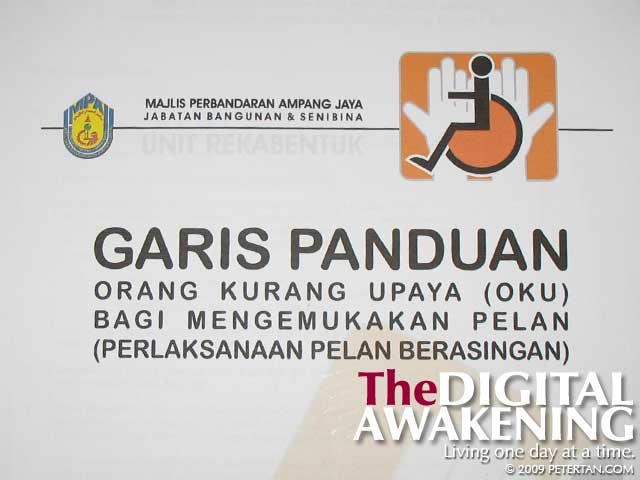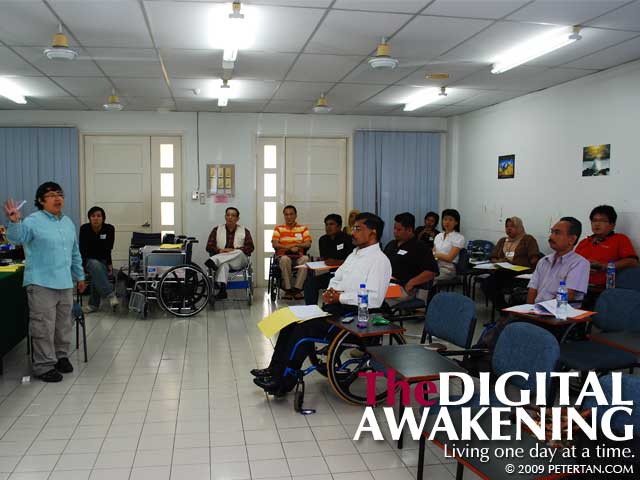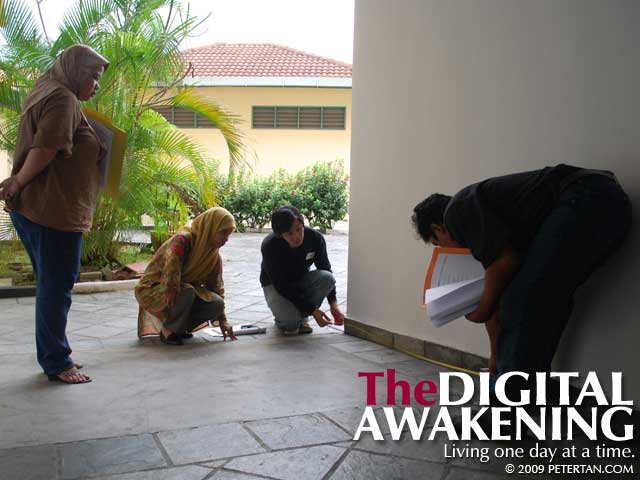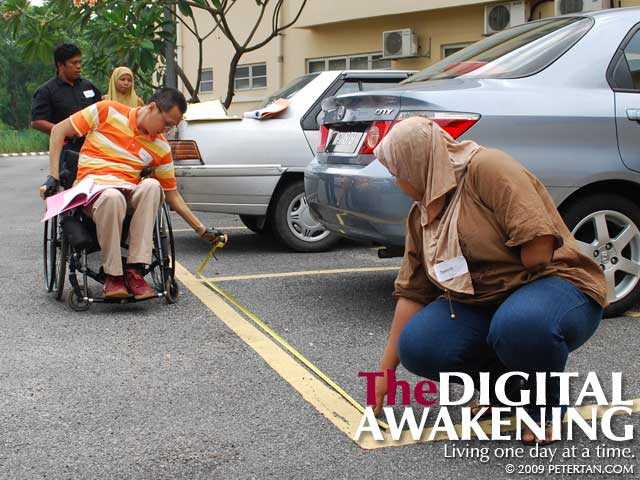Disabled community let down by authorities’ lack of will, poor coordination
by Erna Mahyuni on 28 Apr, 2010
in Cheras, Features, Other Areas.Speaking to people with disabilities advocate Peter Tan, Komunitikini got the rundown on the current situation and challenges faced by the disabled community in Malaysia.
Tan, a trained peer counselor, said that despite existing legislation for building proper facilities for the disabled there was still a lack of accessible facilities for the community.
“My trips out are still limited to places that have some basic accessible facilities such as ramps, (disabled) toilets and elevators.” The lack of these facilities hamper Tan and others like him who struggle with an environment that does not take into account their challenges in doing something as fundamental as moving around.
“There is better awareness of (our) issues but the situation is not improving, ” said Tan. He attributed it to a general “lack of will” on the part of the authorities whether they were at federal, state or local levels to take the necessary steps to improve things.
Citing the existence of the Uniform Building By-Law 34A, which had been in existence since the mid-90s, he said that the law required new buildings to provide access for the disabled. Builds already completed or under construction when the by-law was gazetted were given three years to comply with the applicable standards for construction: Malaysian standards MS 1183 and 1184.
“15 years on,” he noted, “Many buildings still do not comply with those requirements.”
Another problem, Tan noted is the lack of enforcement of said standards.
“Compliance with the UBBL 34A is the responsibility of the local governments, but they do not have qualified personnel to ensure compliance.”
Of the newer buildings that do include disabled facilities, Tan said that often the facilities were not built according to standards. For instance, disabled toilet stalls that were too small, doors that open inside, ramps that were too steep were common problems coupled with street environments that Tan called “totally hostile to disabled people.”
He noted The Gardens at Mid Valley City as an example of near perfect accessible facilities. “If not for the ramp leading to the lift lobby at P2.” Tan said the ramp had a flaw that could cause a wheelchair to tip backwards.
What irks Tan is that though there may be accessible buildings, getting to them is difficult. “What we have here is an island of accessible facilities in an ocean of barriers, ” he said. He called it a circle of mobility that was, for most disabled people, broken in many parts.
Asked about what could be done about the situation, Tan said one step would be for the disabled to unite and find a common platform.
“Many are interested in charity at the expense of advocating for the rights of disabled people.
“First, we need to come together and work together for the common good. Our voices cannot be heard if we don’t speak in a united voice.
“There are too many people trying to do the same thing,” he said.
Tag: Undang-Undang Kecil 34A Undang-Undang Kecil Bangunan Seragam
MPAJ Launches Guidelines For Accessible Facilities

In conjunction with its Hari Kesedaran dan Simulasi OKU last Thursday, Majlis Perbandaran Ampang Jaya also launched the Garis Panduan Orang Kurang Upaya (OKU) Bagi Mengemukakan Pelan (Perlaksanaan Pelan Berasingan). Translated it means Guidelines for Plan Submission for Disabled People (Implementation of Separate Plan). In my opinion, it should have instead read as: Garis Panduan Bagi Mengemukakan Kemudahan OKU or Guidelines on Facilities for Disabled People.
That aside, I am glad that disabled people have come to this stage in our advocacy for accessible facilities in the Ampang Jaya municipality. This is a very positive step for many of us who have been looking forward to such facilities. The guidelines have a checklist and specifications on ramps, pathways and corridors, stairs, doors and entrances, elevators, toilets, lobby and car parking spaces.
The most important aspect of this implementation is the requirement for the submission of a separate plan for accessible facilities. This is to ensure that the plans comply with Malaysian Standard MS 1184 before they are approved. This guideline left out Malaysian Standard MS 1183: Part 8: 1990: Specifications for Fire Precautions in the Design and Construction of Buildings Part 8: Code of Practice for Means of Escape for Disabled People which I feel should have been included.
Teratai ADUN Jenice Lee, MPAJ Council Member Chan Su Sann and MPAJ Jabatan Belia dan Masyarakat Officer Noryani Roslan have been instrumental in pushing this matter up to this stage. Nevertheless, I will raise a few points regarding the guideline as I feel that the requirements are not comprehensive or specific enough. All said, I am happy to see progress in this matter although the moving is slow from the first time I lodged a complaint with MPAJ in 2006.
Importance Of Access Audit In Malaysia

Photo by Wuan.
The Persatuan Orang-Orang Cacat Anggota Malaysia (POCAM) through its Accessibility Committee headed by Elizabeth Ang organised an Access Audit Training for members of the association. The training was conducted by Naziaty Yaacob. She is the senior lecturer at the Department of Architecture, University of Malaya, and is very experienced in accessibility issues in the built environment.
I have been advocating for an accessible built environment and the Malaysian Standard MS 1184 in this blog for a while now but have never really gone into the details that go into making the infrastructure fully accessible. After the training, I realised that there were many issues that I have overlooked, especially the intrinsic details that makes a difference between endangering the lives and making public facilities safe.

Photo by Wuan.
The training was held at the Institut Latihan Majlis Kebajikan dan Pembangunan Masyarakat Kebangsaan Malaysia (MAKPEM) in Sentul. I have stayed there a once and had thought that the building was a good accessible model to duplicate as trainings for disabled people were often conducted there. It was only after the access audit exercise that we discovered a number of the facilities do not conform to the Malaysian Standard MS 1183 and MS 1184.
Accessibility is not only about ramps and toilets for wheelchair users. It is also not exclusively for disabled people. Society in general benefits from such facilities as they are safe and convenient to use. Take for example the staircase. Nosing with contrasting colour is important for indicating the edge of the steps. Wuan and I personally witnessed an elderly man falling down outside Metrojaya Bukit Bintang. He lost his footing walking unaware down an unmarked step. Fortunately he did not suffer any injury.

Photo by Wuan.
Access auditing is important in identifying barriers in the infrastructure that needs to be rectified. This will ensure that everyone has equitable use of public facilities. Malaysia still has a long way to go in this aspect. Most public buildings do not fulfil the requirements of the code of practice. This includes essential government facilities. Accessibility in the built environment is one of the two core issues affecting disabled people that has not been given due attention. The other is public transport.
The local authorities are the biggest culprit in this deplorable state of affairs as they have never seriously enforced By-Law 34A of the Uniform Building By-Law (UBBL 34A) requiring that buildings provide access for disabled people. The UBBL 34A has been in force since the 1990s. Fifteen years on, many new buildings still do not conform to MS 1184. As long as the various levels of government is not serious in resolving accessibility issues, disabled people in Malaysia will continue to be marginalized.


